Beginnings of the Holodeck: AMD's DX11 GPU, Eyefinity and 6 Display Outputs
by Anand Lal Shimpi on September 10, 2009 2:30 PM EST- Posted in
- GPUs
Wanna see what 24.5 million pixels looks like?

That's six Dell 30" displays, each with an individual resolution of 2560 x 1600. The game is World of Warcraft and the man crouched in front of the setup is Carrell Killebrew, his name may sound familiar.
Driving all of this is AMD's next-generation GPU, which will be announced later this month. I didn't leave out any letters, there's a single GPU driving all of these panels. The actual resolution being rendered at is 7680 x 3200; WoW got over 80 fps with the details maxed. This is the successor to the RV770. We can't talk specs but at today's AMD press conference two details are public: 2.15 billion transistors and over 2.5 TFLOPs of performance. As expected, but nice to know regardless.
The technology being demonstrated here is called Eyefinity and it actually all started in notebooks.
Not Multi-Monitor, but Single Large Surface
DisplayPort is gaining popularity. It's a very simple interface and you can expect to see mini-DisplayPort on notebooks and desktops alike in the very near future. Apple was the first to embrace it but others will follow.
The OEMs asked AMD for six possible outputs for DisplayPort from their notebook GPUs: up to two internally for notebook panels, up to two externally for conncetors on the side of the notebook and up to two for use via a docking station. In order to fulfill these needs AMD had to build in 6 lanes of DisplayPort outputs into its GPUs, driven by a single display engine. A single display engine could drive any two outputs, similar to how graphics cards work today.
Eventually someone looked at all of the outputs and realized that without too much effort you could drive six displays off of a single card - you just needed more display engines on the chip. AMD's DX11 GPU family does just that.
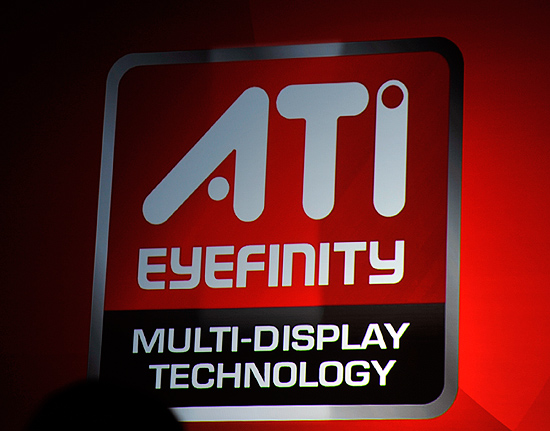
At the bare minimum, the lowest end AMD DX11 GPU can support up to 3 displays. At the high end? A single GPU will be able to drive up to 6 displays.

AMD's software makes the displays appear as one. This will work in Vista, Windows 7 as well as Linux.
The software layer makes it all seamless. The displays appear independent until you turn on SLS mode (Single Large Surface). When on, they'll appear to Windows and its applications as one large, high resolution display. There's no multimonitor mess to deal with, it just works. This is the way to do multi-monitor, both for work and games.
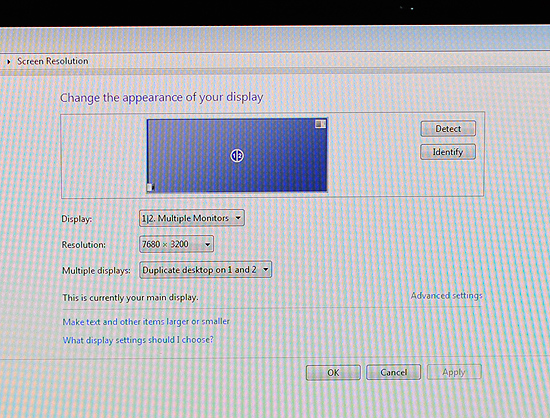
Note the desktop resolution of the 3x2 display setup
I played Dirt 2, a DX11 title at 7680 x 3200 and saw definitely playable frame rates. I played Left 4 Dead and the experience was much better. Obviously this new GPU is powerful, although I wouldn't expect it to run everything at super high frame rates at 7680 x 3200.
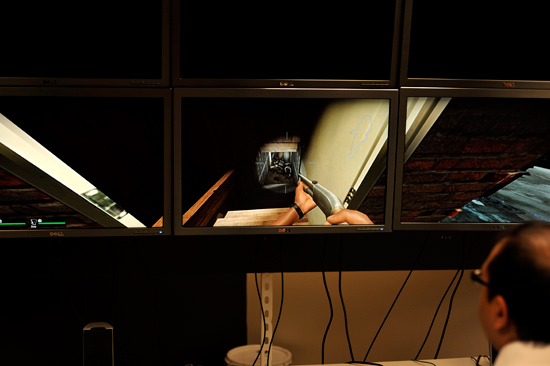
Left 4 Dead in a 3 monitor configuration, 7680 x 1600
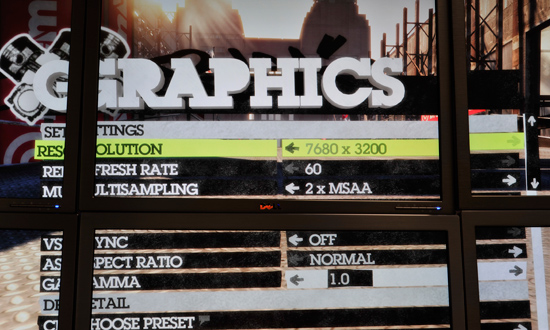
If a game pulls its resolution list from Windows, it'll work perfectly with Eyefinity.
With six 30" panels you're looking at several thousand dollars worth of displays. That was never the ultimate intention of Eyefinity, despite its overwhelming sweetness. Instead the idea was to provide gamers (and others in need of a single, high resolution display) the ability to piece together a display that offered more resolution and was more immersive than anything on the market today. The idea isn't to pick up six 30" displays but perhaps add a third 20" panel to your existing setup, or buy five $150 displays to build the ultimate gaming setup. Even using 1680 x 1050 displays in a 5x1 arrangement (ideal for first person shooters apparently, since you get a nice wrap around effect) still nets you a 8400 x 1050 display. If you want more vertical real estate, switch over to a 3x2 setup and then you're at 5040 x 2100. That's more resolution for less than most high end 30" panels.
![]()
Any configuration is supported, you can even group displays together. So you could turn a set of six displays into a group of 4 and a group of 2.
It all just seems to work, which is arguably the most impressive part of it all. AMD has partnered up with at least one display manufacturer to sell displays with thinner bezels and without distracting LEDs on the front:
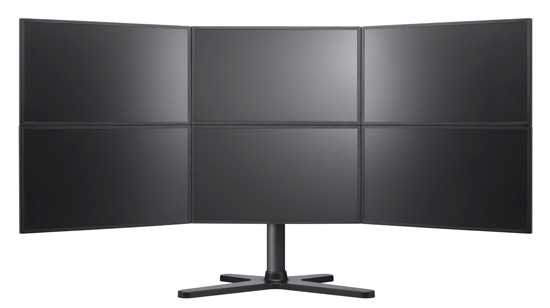
A render of what the Samsung Eyefinity optimized displays will look like
We can expect brackets and support from more monitor makers in the future. Building a wall of displays isn't exactly easy.










137 Comments
View All Comments
Chlorus - Friday, September 11, 2009 - link
Can someone do my sanity a favor and ban this idiot? Do you think he actually has a job? Hell, does anyone even think he has a frakking GED? I love how he thinks every review site is engaged in a mass conspiracy against AMD.Lonyo - Thursday, September 10, 2009 - link
Yeah that's why the Radeon HD4870 review was "HD4870 - The Card To Get".Almost every preview article (this is a preview article) doesn't have any kind of flashy subtitle/comment, just a quick summary of what it's about.
When the reviews of the ATI DX11 cards come out, I am sure they will have some sort of zany subtitle/comment about how amazing they are (since compared to current gen they are sure to be amazing, and I doubt by that time based on rumour we will have anything from nvidia except pre-release benchmarks if they feel desperate).
skrewler2 - Thursday, September 10, 2009 - link
I didn't see this in the article. How does a graphics card with two outputs drive 6 displays? What hardware is needed to do this? Is there some kind of splitter or DP box they all plug into? I have two dell 3007wfp-hc's already and this is making me want to buy a 3rd, but I don't know if I need anything else to drive it.Dudler - Friday, September 11, 2009 - link
I think they use the "Trillian" AIB, or possibly known as the "Six". It features six mini-displayport outputs. Other articles on the net show ATi demonstrating a 24 monitor setup using 4(!!) Six cards..I dont know which setup(gpu) the "six" cards uses, rumours were both Cypress(aka r870) and Hemlock(akar800). From the coolers shown, I think it uses "just" Cypress.(Single chip not duallie).
I also believe that the long socalled 5870 card shown in photos around the net is Hemlock(5870x2), not 5870.
And for you concerned about your power bill, rumours state that the 5870 uses 28W(!!!!!!) in idle and 2D.
This ATi generation rocks, I only hope nVidia will get their card out and survive. Anyway how you look their future is bleak. Their chipset business is coming to an end except for AMD cpu's, and theyre late with the gt300.
snakeoil - Thursday, September 10, 2009 - link
come on you have a brain, what about two cards in crossfire.skrewler2 - Thursday, September 10, 2009 - link
Uh, in the article they said one card was driving 6 monitors.. what the fuck does your comment even mean?wifiwolf - Thursday, September 10, 2009 - link
from page 1:"The OEMs asked AMD for six possible outputs for DisplayPort from their notebook GPUs: up to two internally for notebook panels, up to two externally for conncetors on the side of the notebook and up to two for use via a docking station. In order to fulfill these needs AMD had to build in 6 lanes of DisplayPort outputs into its GPUs, driven by a single display engine. A single display engine could drive any two outputs, similar to how graphics cards work today."
mczak - Thursday, September 10, 2009 - link
I can't make much sense out of this however. Current cards have two independent display controllers. These two display controllers afaik don't really share anything, so referring to them as one display engine doesn't really make a lot of sense. So any rv870 really has 6 display controllers (though probably not that many internal tmds transmitters, so if you'd want to drive more than 2 dvi/hdmi displays I'd guess you're out of luck or you'd need a card with external tmds transmitters)?mczak - Thursday, September 10, 2009 - link
actually no all passive DP/DVI converters should still work. You just need enough space on your desk :-)therealnickdanger - Thursday, September 10, 2009 - link
Am I the only one here that thinks the real story is not the multi-monitor support, but rather the ridiculous GPU power driving them all? I realize they haven't fully disclosed the specs publically, but 7000x3000 resolution over 60fps? The article barely seems impressed by these numbers. Was this the performance expected from single-GPU setups for this generation? I didn't see this coming at all and I'm completely floored!Also, I would just like to add that I have always preferred being able to segregate displays so that I can easily maximize multiple applications within their own screen. Having everything as "one giant display" has been possible for years and is a less than desirable for everything BUT gaming... IMO